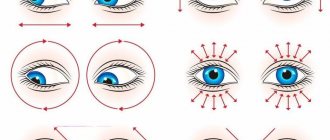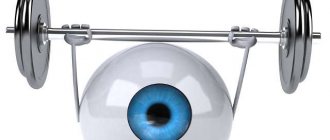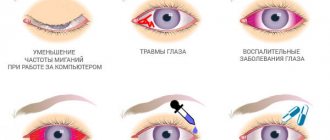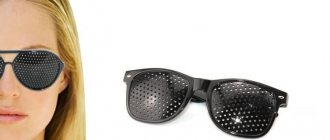In modern ophthalmological practice, there are a large number of ways to correct such a common pathology as myopia. One of them is medical conservative treatment. Let's consider how effective it is and what features need to be taken into account.
In this article
- What is myopia?
- Causes of myopia
- Symptoms of myopia
- Degrees of myopia
- False myopia
- Treatment of myopia: methods
- Types of drugs to treat myopia
Drugs that improve vision for myopia, farsightedness and other diseases
Today, the problem of decreased visual acuity has become widespread everywhere.
People of different ages and different professions have already encountered it and are faced with it every day. The complexity of its solution lies in the fact that it is almost impossible to identify a group at risk of developing pathology, because the causes of vision loss are very different and depend on many factors, including: genetic predisposition, occupational characteristics, intrauterine development anomalies, the ecological environment of the place of residence, light conditions, nutrition, the presence of physiological pathologies, the frequency of stress, physical activity, and a person’s everyday habits. But to restore normal vision, many methods have been developed, not the least of which are special medications.
Gene therapy
Inherited eye diseases can also cause blindness or early vision problems. Therefore, ophthalmology also needs genetic treatment methods that would correct mutated parts of the genome. So far, a solution has been found only for Leber amaurosis, a rare hereditary disease of the retina. Aniridia, achromatopsia and other incurable genetic problems are next in line.
It is possible that in 10 years, by rewriting several sections of the genetic code, it will be possible to make a blind person sighted again, which allows us to rightfully say: “We’ll wait and see!”
Medicines for the eyes
According to their effects, medications for improving vision are usually divided into three groups:
- Medicines whose action is aimed at relaxing the eye muscles. The best known drug in this group is Atropine. It is prescribed only by a doctor and acts by dilating the pupil, which provides peace and relaxation to the ciliary muscle, which relieves spasm of accommodation and eliminates false myopia.
- Drugs that help relax the eyes during night sleep. These products include Shtuln drops. Medicines in this group are very useful for prolonged eye strain, for example, during daily work at a computer monitor.
- The third group includes drugs whose action is aimed at improving the functional state of the retina. These are antioxidants of plant origin or vitamins for the eyes, such as Aevit, Triovit, etc. Particularly noteworthy are multivitamin complexes, which contain complex combinations of vitamins with microelements (zinc, selenium, calcium), as well as products based on the blueberry plant: Blueberry-forte, Strix, Okovit, Luminocap, etc. At one time, tea containing dried blueberries was quite widely used. Blueberries mashed with sugar also have an excellent effect. When using ready-made preparations containing blueberry extract, you should pay attention to the concentration of substances they contain that are beneficial for the retina. For example, when a capsule or tablet of the drug can replace up to two kilograms of fresh berries. Such drugs improve the nutrition of eye tissue, help replenish reserves of the visual pigment rhodopsin, and improve vision. Blueberry extract is also prescribed for the treatment of such a serious age-related disease as retinal dystrophy.
Psychotropic substances.
To treat anxiety conditions and relieve emotional stress, the doctor may prescribe tranquilizers to the patient (for example, from the group of benzodiazepines). They have a powerful calming and anti-anxiety effect, helping to get rid of fears and obsessive thoughts. Many tranquilizers also have a hypnotic effect and can be used for insomnia. Possible side effects of the use of psychotropic substances may be visual impairment, deterioration in the ability to adequately perceive the depth of space, etc.
Tablets for vision
Restoration of vision is also facilitated by taking 500 mg tablets of regular calcium gluconate before meals. At the same time, for adults the required frequency of daily intake is 3 times, for children 7-9 years old - once or twice, for adolescents 10-14 years old - two or three times. The course of treatment for everyone is 10 days. A useful property of calcium gluconate is to reduce vascular permeability, prevent hemorrhages in the eye and strengthen the outer membrane of the eye, in addition, it suppresses allergic reactions. Ascorbic acid is used to strengthen the sclera. It stimulates metabolic processes in eye tissues and activates collagen synthesis. Ascorbic acid tablets are taken daily 2-3 times, 50 or 100 mg of the drug for a month.
Analogs
There are no constructive analogues to the drug, but there are ophthalmic agents with a similar effect:
- Ophthalamin. Protein complex isolated from the tissues of bovine eye cells. It is used in the diagnosis of diabetic retinopathy, in the case of retinal dystrophy, and successfully increases visual acuity. Produced in tablet form, taken within 10–15 minutes. before meals, twice a day, 0.01–0.02 g. The course of treatment is 10–12 days. The price of the drug is 400 rubles.
- Vidisk. An eye gel that moisturizes and protects the cornea of the eye. It contains the active substance – harbomer. The film that the gel creates after application imitates the water-mucin layer of tear fluid. Used for insufficient tear production and dry eye syndrome. Apply 1 drop of gel daily 3-4 times a day. Price 300 rub.
- Korneregel. Local agent that stimulates regeneration processes. The active substance of the eye gel is dexpanthenol, which is a precursor of pantothenic acid. This acid has biological properties, takes part in metabolism, the synthesis of basic substances of connective tissue, which turn into fibrocytes. The drug is instilled into the area of the lower conjunctival sac, 1 drop three times a day. Apply:
- for non-inflammatory keratopathy;
- in case of damage to the cornea by bacterial, fungal, viral infections;
- for healing the cornea after thermal and chemical burns.
The price of the drug is 500 rubles.
- Okoferon. Ophthalmic lyophilisate, contains alpha 2B - recombinant human interferon 1,000,000 IU. A bottle of 1 ml of prepared eye drops contains 200,000 IU of interferon. Used for instillation in case of viral eye lesions. Use in pediatrics is not recommended. The course of treatment lasts 7–10 days. Daily intake – 2 drops, administered one at a time every 2 hours. The substance initiates intracellular changes that slow down the proliferation of cellular tissues. The price of the drug is 135 rubles.
- Artelak. Moisturizing ophthalmic solution. Contains hyaluronic acid, boric acid, vitamin B12. The sterile solution moistens and lubricates the ocular surface. The electrolytes contained in the composition act as regulators of the biochemical processes of cellular eye tissues. The drug does not affect the physiological state of the eyes. Recommended in cases of chronic tear deficiency and inflammatory processes. Price from 600 rub.
- Quinax. Ophthalmic solution is used to treat various forms of cataracts. The most popular remedy in the treatment of this disease. The active substance contained in the drops is azapentacene. It protects the sulfhydral groups of lens proteins.
- Taurine. The product is available in the form of drops and contains 40 mg/ml taurine as an active ingredient. Refers to amino acids that are produced by the body during the conversion of cysteine and are involved in the construction of protein molecules. Promotes cellular metabolic processes, during which cells are supplied with energy. Helps restore tissue in dystrophic diseases when the metabolism of eye tissue is disrupted. Instillations are carried out 1-2 drops 2-4 times/day. The course of treatment is 3 months. Prescribed for:
- dystrophy, corneal injury;
- cataracts: senile, radiation, traumatic.
Price of the drug: 57 rub. for 10 tube-ampoules.
- Oftan Katahrom. Eye drops containing active substances - adenosine 2 mg, nicotinamide 20 mg, cytochrome C 0.65 mg. Improves the metabolic process of the lens, used for cataracts. Nicotine reduces the rate of cataract development, adenosine dilates blood vessels, restoring microcirculation, oxygen saturation of the blood, and rejects toxins. Cytochrome C neutralizes free radicals and participates in the regulation of redox processes. The drug is low-toxic and can be used not only for treatment, but also to prevent the development of cataracts. Prescribe 1-2 drops three times a day. After instillation, there may be tingling in the eye, a burning sensation, and allergic conjunctivitis often occurs. The price of the drug is from 350 rubles.
- Emoxipin. Eye drops improve microcirculation and capillary permeability. Active ingredient: methylethylpyridinol hydrochloride, 10 mg. Protects the retina from exposure to high intensity light, promotes the resorption of hemorrhages inside the eye, and stabilizes cell membranes. Children and pregnant women are not recommended to use drops. Therapeutic dose: 1-2 drops 2-3 times/day. The course of treatment is up to 180 days. Applicable for:
- diabetic retinopathy;
- hemorrhage in the area of the anterior eye chamber;
- complicated myopia;
- thrombosis of the central vein and its branches in the retinal area.
Price of the drug: from 180 to 300 rubles.
All of the above drugs are prescribed by a doctor in accordance with the symptoms and disease.
Drugs for myopia
Prevention and treatment of myopia (myopia) requires the use of drugs that improve hemodynamics. So, for mild myopia, Halidor and nicotinic acid can be prescribed (preferably in combination with ascorbic acid). Vasodilator drugs Trental and Nigexin are prescribed for high degrees of progressive myopia.
In case of serious complications of myopia, tissue preparations may be prescribed. Particularly effective in this case is a solution of a suspension of placental tissue, which is injected subcutaneously. It should be borne in mind that tissue therapy cannot be used at the time of puberty.
In order to prevent or treat hemorrhagic complicated myopia, to strengthen the vascular wall, rutin (20 mg each) and ascorbic acid (50 or 100 mg each) are prescribed, up to 3 times a day, for at least 3-4 weeks. Often these drugs are replaced with Ascorutin tablets, which are taken 50 mg 2-3 times a day for the same duration. It is necessary to take into account that Rutin and Ascorutin cannot be used if there is increased blood clotting and a tendency to thrombus formation.
What is myopia?
People suffering from myopia have trouble seeing objects located far from them, but they can see well up close. This is due to the fact that light rays that are refracted in the visual system do not fall on the retina, as happens with normal
In this article
conditions, and in front of her. The eyeball, under the influence of certain factors, becomes enlarged and elongated, and the ability to accommodate decreases. Ophthalmologists measure the degree of refractive pathologies in diopters. If a patient is diagnosed with myopia, a “-” sign appears before the optical power indicator after vision diagnosis (for farsightedness “+”). It is important to know that the worse a person’s vision, the more serious the severity of the disease. There are three degrees of myopia:
- Weak - up to -3 diopters. There is an increase in the eyeball by 1-2 mm. A person cannot distinguish the outlines of objects and inscriptions at a distance of 10 m;
- Average - from -3.25 to -6 diopters. The eyeball lengthens by 3-3.5 mm. It becomes difficult for a person to navigate in space without vision-correcting means; he can clearly distinguish only those objects that are no further than arm’s length.
- High - over - 6 diopters. The anteroposterior axis of the eyeball is excessively enlarged, and therefore problems may arise in the circulatory system of the eyes, the walls of blood vessels become weak and thin, and degenerative changes in the visual apparatus are observed. A person sees objects at a distance of 5-10 cm from the face.
Only after a comprehensive examination of the patient’s vision will a specialist be able to determine the severity of the pathology and, based on the data obtained and the person’s lifestyle, prescribe treatment for myopia.
Operations
The advent and improvement of laser correction has made many eye surgeries much safer, even routine, so that they now involve significantly less risk than before. The excimer laser allows you to preserve the integrity of the eyeball and the biomechanics of the eye, eliminating many previously incurable diseases.
And recently, even some completely blind people have a chance to regain their sight: a bionic retina, which they have learned to implant, will help restore their sight. A microscopic device, consisting of a camera, processor, receiver, wires and microchips, is implanted directly into the human retina and transmits the image to the brain via the optic nerve. It may soon be possible to restore vision to those whose optic nerve is atrophied: the image will be wirelessly transmitted directly to the visual center of the brain, where it is also planned to install chips.
Restoring vision in myopia: medication method
It is necessary to understand that vision tablets, drops and other medications are auxiliary means of treating the disease. This is due to the fact that eye medications do not affect the restoration of the lens and change the shape of the cornea. Most often, certain drops and medications are prescribed to stabilize vision by activating the nutrition of the visual system. In addition, experts strongly recommend undergoing a course of treatment for myopia 1-2 times a year using the best, high-quality medications. The ophthalmologist can select them only after diagnosing vision and talking with the patient. The doctor will write a prescription and give important recommendations on the frequency and dosage of taking medications.
Types of medications that help improve vision
Ophthalmologists distinguish three groups of drugs that help treat myopia:
- Drugs that artificially relax the eye muscles. One of the most famous is Atropine.
- Medicines that provide relaxation of the eyes during sleep, for example, Shtulna drops. Medicines of this type are indicated for people who are regularly exposed to heavy loads: prolonged work at the computer, reading, working with small objects.
- Drugs aimed at improving the condition of the retina. As a rule, these are antioxidants of plant origin. For example, vitamins “Aevit” and “Triovit”, “Myrtilene forte”. Multivitamins are especially useful for restoring poor vision, which contain trace elements such as calcium and zinc, as well as medicine containing blueberries (“Blueberry forte”, “Phytoblueberry”). These medications improve blood circulation in the eyes, restore the visual pigment - rhodopsin, and help get rid of retinal muscle dystrophy.
"Live" vitamins
First of all, you should adjust your diet. The maximum benefit for the body comes from vitamins contained in fresh food. What foods are recommended for farsightedness? It is necessary to increase the consumption of foods containing large amounts of potassium: potatoes, raisins, legumes, bananas, etc.
Fatty and sweet foods should be removed from the diet. Cigarettes, alcohol, and coffee should also be excluded. The diet should be dominated by products of plant origin: fresh fruits and vegetables. Foods rich in vitamins A and C are especially useful. For farsightedness, you should consume vitamin B12, β-carotene, zinc, lutein, selenium, and blueberry anthocyanins.
Blueberries contain biologically active substances - anthocyanins. They improve vision parameters, normalize blood circulation and relieve eye fatigue. Kiwi, spinach and celery are rich in lutein. Lutein protects the eyes from early aging.
Eye drops
In ophthalmology, it is customary to classify eye drops as topical medications. Treatment of myopia occurs with the help of vitamin solutions containing active components of targeted action. This or that medicine of this type helps improve metabolic processes in the eye tissues, reduces the progression of myopia, and stabilizes the pathological process.
It is important to understand that any drops are medications, so their use without the prescription of an ophthalmologist is strictly not recommended.
Almost all drops that provide treatment for different degrees of myopia are produced in tightly closed bottles equipped with a dispensing pipette, which makes their use as convenient as possible.
The user needs to know that once bottles of medications are opened, they will have a limited shelf life. Therefore, before using them, you should study the instructions in detail.
If discomfort occurs when using drops to improve vision, you should stop using them and consult a doctor immediately.
The most effective drops for restoring vision in myopia
When a patient has a mild form of myopia, specialists often prescribe the drug Taufon. It contains taurine, which has a regenerative function. With its use, improvements are observed due to the acceleration of metabolic processes and the supply of the optimal amount of oxygen for the proper functioning of the visual system. No less popular are Emoxipin drops with an active synthetic antioxidant. Treatment with this drug occurs due to improved blood circulation, resorption of small hemorrhages and protection of the retina from negative external environmental factors. The drug for improving vision “Irifrin” is also highly effective. It promotes pupil dilation, outflow of intraocular fluid and vasoconstriction. However, the drug has contraindications. For example, it cannot be used for diseases of the thyroid gland and cardiovascular system. That is why you should consult an ophthalmologist to find out the permissible frequency and dosage of its use.
Experts also recommend “Ujala” drops for the treatment of myopia. This is an Ayurvedic medicine that relieves fatigue and eye strain. It is enriched with active ingredients such as potassium nitrate and Boerhavia diffuse extract. The first has an antimicrobial and analgesic effect. The second reduces eye strain, which accompanies lacrimation with uncomfortable sensations, and also stimulates nutrition and metabolic processes at the cellular level. The drug does not contain harmful chemical components, so it can be used even by patients with hypersensitive organs of vision.
Glasses and lenses
The most traditional method of vision correction, which, however, is experiencing a rebirth in our time, is optical. This is not only because new materials have emerged that allow for greater reliability and precision, but also because of the many innovative functions that glasses can perform.
- For example, changing the focus of vision (solving the problem of “distant glasses” and “reading glasses”) - a person can switch modes from distant vision to near vision, and to do this it is enough just to lower his head. Between the two lenses there is a liquid crystal display, which switches modes.
- Glasses for colorblind people have also been invented, the lenses in which are made approximately like lenses for protection from lasers - with filters of the color spectrum that cut off part of the rays and transmit basic colors (such lenses, of course, are not suitable for all colorblind people and only work in natural light).
- There are dozens of similar solutions nowadays. Let's choose one more thing - electronic glasses for training binocular vision (for example, for amblyopia and strabismus): glasses with alternating darkening lenses. Such glasses allow the patient to train the extraocular muscles, maintain or recreate the connection between the retina and the brain.
The functional characteristics of contact lenses also improve. Modern implantable lenses allow you to correct not only myopia, but also more complex defects, and wearable lenses become toric and are stably fixed on the eyeball.
Recently, in the USA, they created a ring implanted into the cornea, which does not treat senile presbyopia, but can become an alternative to glasses: near vision improves by 80% when using it.
Meet the ophthalmologists of the Euromed clinic
Preparations for restoring vision: complexes of useful substances
As mentioned earlier, complexes containing lutein and blueberries are considered one of the best, most effective and popular medicines. This berry increases visual acuity and improves blood circulation in the retina.
Preparations for restoring vision containing blueberries:
- “Blueberry forte” - in addition to blueberries, the complex includes rutin, calcium and zinc;
- "Meller" - contains fish oil and blueberry juice;
- "Doppelherz" - includes blueberry extract, bioflavonoids, lutein and fish oil.
A component such as lutein helps neutralize the negative effects of bright light (photophobia), stops the progression of myopia, maintaining good vision, and slows down aging.
The most popular vitamin complexes with lutein:
- “Lutein Forte” - the medication contains microelements that slow down the aging process of cells in the visual system;
- “Lutein complex” - includes, in addition to lutein, amino acids, carotenoids and vitamins A, B, C and E.
- Doppelhertz with lutein - also contains antioxidants that reduce the risk of eye inflammation.
Tablets to improve vision for myopia
Popular medications for intravenous administration include Ascorutin and Omega 3, which are often produced in capsules with fish oil.
- "Ascorutin" is a combination tablet indicated for people with myopia. They contain rutin, which prevents hemorrhages in the visual system, as well as ascorbic acid, which strengthens the walls of the eye vessels. Tablets should be taken 2-3 times a day with a dosage of 50 mg.
- Omega 3 helps improve color vision and eliminate night blindness, making the body more resistant to adverse environmental factors. Medicines containing such acids are very important for the proper circulation of enzymes in the tissues of the eyes; they prevent inflammation of the cornea. The most convenient form of taking medications is gelatin capsules.
Solutions and drops for the treatment of myopia
In ophthalmological practice, various types of eye solutions are actively used: antibacterial (for the treatment of infectious pathologies that may be accompanied by a decrease in visual ability), anti-inflammatory (non-steroidal and hormonal), moisturizing, vasoconstrictor (improving metabolic processes in the tissues of the visual apparatus).
The most proven and effective solutions for treating vision with myopia include:
- "Nigexin" - a drug used to normalize visual function, narrows the eye vessels.
- “Zorro” - reduces tension in the visual muscles, effectively relaxes the eyes, relieves itching, burning and dryness. The drug contains natural ingredients and vitamins. Indicated for spasm of accommodation.
- "Kuspavit" - eliminates the negative effects of harmful radicals and toxins on the visual organs.
- “Reticulin” has a protective function, prevents fatigue of the visual organs, makes them less sensitive to radiation emanating from gadgets, computer monitors, TVs, etc.
- “Cytochrome C” - effectively removes various harmful elements from the eye tissues, relieves fatigue, and prevents the progression of myopia.
- “Shtulna” - helps to relax and relieve eye fatigue. Drops are indicated for regular use by people whose work takes place at the computer.
- "Oftan Katahrom" - a solution prescribed for the prevention of cataracts. It contains various active components: adenosine (normalizes blood flow and circulation of intraocular fluid, has an anti-inflammatory and restorative effect), cytochrome (antioxidant), nicotinamide (improves hematocirculation, neutralizes toxins).
- “Sante 40” - includes taurine, panthenol and vitamins B6 and E. It stimulates tissue regeneration of the visual organs, normalizes intraocular pressure, relieves swelling and itching. Helps improve visual acuity after heavy loads on the visual system.
Treatment for myopia is selected for each patient individually after appropriate research. The dosage and frequency of use of the drugs is determined by the ophthalmologist. After each course of treatment a break is required.
It is very important to understand that therapy using solutions must be carried out in combination with a proper, balanced diet. It is important to include berries, fresh vegetables and fruits in your diet, as well as a sufficient amount of water (at least 2 liters per day).
To restore vision, foods such as carrots, parsley, bell peppers, spinach, and fish are very useful. Also, eye exercises should be included in the treatment complex; it will help tone the muscles.
Rules for the use of drops and solutions for the treatment of myopia
Despite the fact that putting eye drops in your eyes is not at all difficult, the procedure still requires compliance with certain rules. The fact is that it is necessary that the solution gets into a specific area, otherwise the effectiveness of its action will be reduced. In addition, to prevent infection from getting into the eyes, all actions should be carried out only after hands have been thoroughly washed, preferably with antibacterial soap.
You need to apply eye drops as follows:
- Pull the lower eyelid down slightly;
- Throw your head back;
- Look up;
- Place a few drops of the medicine into the area between the lower eyelid and the eyeball.
After completing the steps described above, you need to lightly press the inner corners of your eyes so that the solution does not leak out. If you wear lenses, agree on the schedule of instillation of the drug while wearing them with your doctor.
source
Neurofeedback and schools of vision
It so happens that most high ophthalmic technologies are invasive (surgeries and injections). A pleasant exception was the development of treatment methods based on biofeedback. These methods make it possible to better teach the brain to control various body functions, including vision. There are numerous devices that allow you to give a person feedback when performing special exercises that train your eyesight.
In some even complex cases, it is possible to improve vision not by treating the eyes, but by teaching the brain to more correctly interpret what the eyes see—to rebuild and retrain visual patterns. For this purpose, so-called vision schools are common in Europe - specially equipped spaces in which the patient, as in a training room, performs various exercises on the ground. For example, he walks along a long corridor in which inscriptions of different colors and sizes appear at different distances. The difficulty level is set according to vision, and the program calculates how long it took the patient to recognize the inscription. The training series ends when the patient becomes tired. The school of vision also has homework, for example, it is suggested to look at small things at different distances, and go to a three-dimensional movie.











